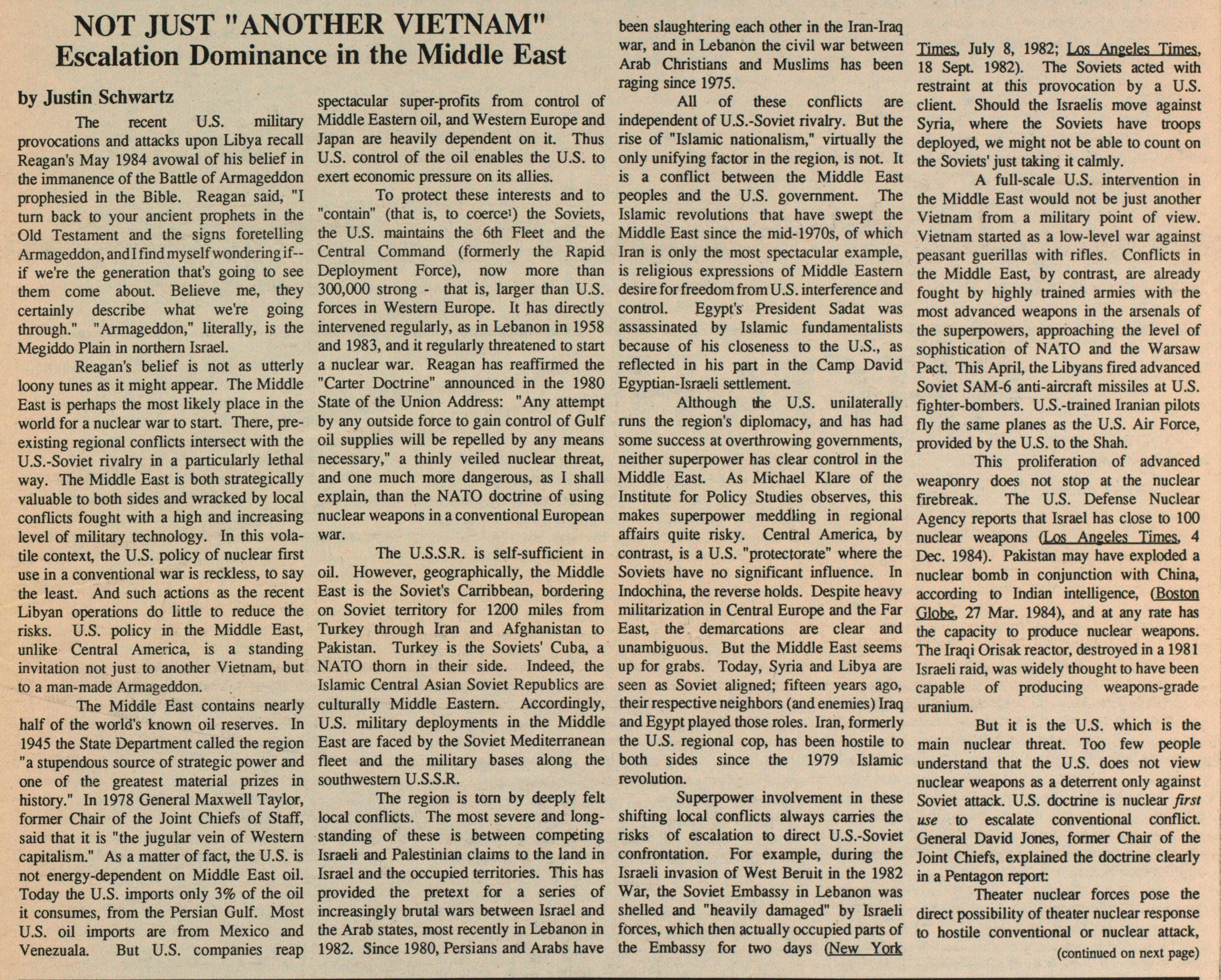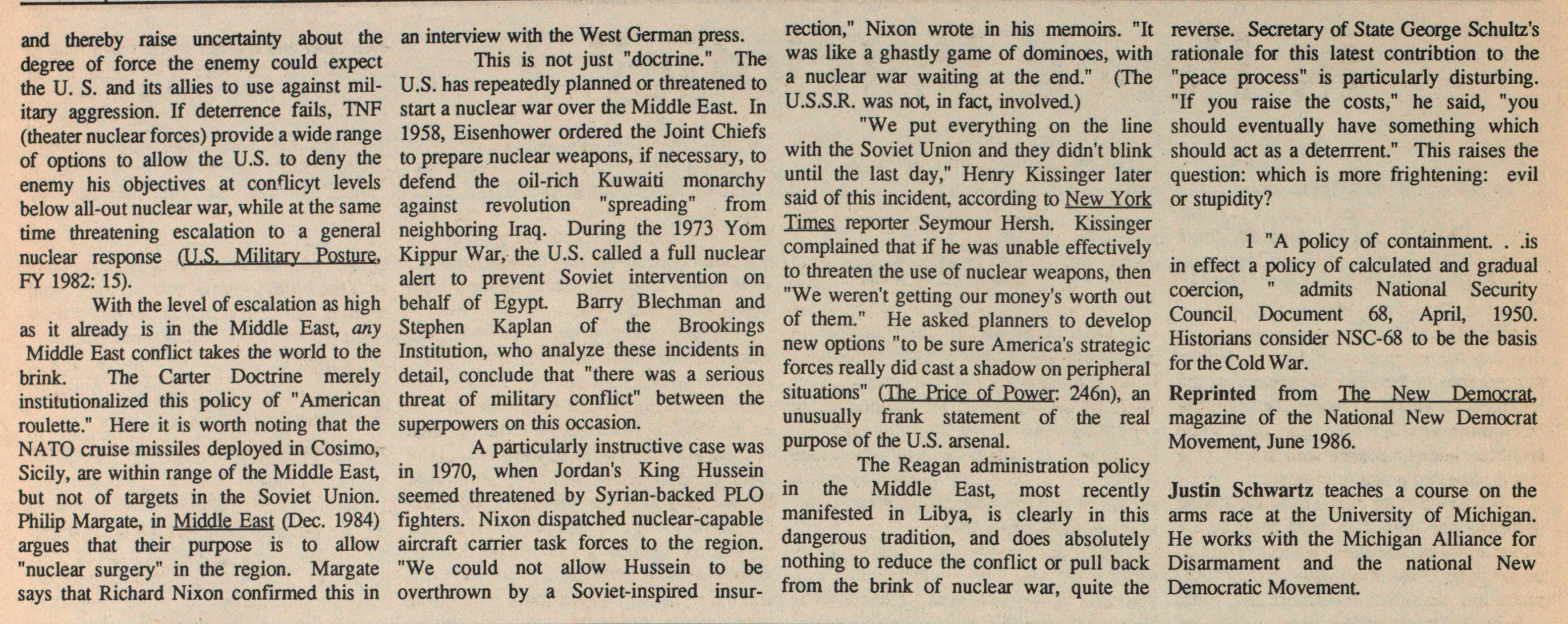Not Just "Another Vietnam" Escalation Dominance In The Middle East by Justin Schwartz


NOT JUST "ANOTHER VIETNAM"
Escalation Dominance in the Middle East
by Justin Schwartz
The recent U.S. military provocations and attacks upon Libya recall Reagan's May 1984 avowal of his belief in the immanence of the Battle of Armageddon prophesied in the Bible. Reagan said, "I turn back to your ancient prophets in the Old Testament and the signs foretelling Armageddon, and I find myself wondering if - if we're the generation that's going to see them come about. Believe me, they certainly describe what we're going through." "Armageddon," literally, is the Megiddo Plain in northern Israel.
Reagan's belief is not as utterly loony tunes as it might appear. The Middle East is perhaps the most likely place in the world for a nuclear war to start. There, preexisting regional conflicts intersect with the U.S.-Soviet rivalry in a particularly lethal way. The Middle East is both strategically valuable to both sides and wracked by local conflicts fought with a high and increasing level of military technology. In this volatile context, the U.S. policy of nuclear first use in a conventional war is reckless, to say the least. And such actions as the recent Libyan operations do little to reduce the risks. U.S. policy in the Middle East, unlike Central America, is a standing invitation not just to another Vietnam, but to a man-made Armageddon.
The Middle East contains nearly half of the world's known oil reserves. In 1945 the State Department called the region "a stupendous source of strategic power and one of the greatest material prizes in history." In 1978 General Maxwell Taylor, former Chair of the Joint Chiefs of Staff, said that it is "the jugular vein of Western capitalism." As a matter of fact, the U.S. is not energy-dependent on Middle East oil. Today the U.S. imports only 3% of the oil it consumes, from the Persian Gulf. Most U.S. oil imports are from Mexico and Venezuela. But U.S. companies reap spectacular super-profits from control of Middle Eastern oil, and Western Europe and Japan are heavily dependent on it. Thus U.S. control of the oil enables the U.S. to exert economic pressure on its allies.
To protect these interests and to "contain" (that is, to coerce¹) the Soviets, the U.S. maintains the 6th Fleet and the Central Command (formerly the Rapid Deployment Force), now more than 300,000 strong - that is, larger that U.S. forces in Western Europe. It has directly intervened regularly, as in Lebanon in 1958 and 1983, and it regularly threatened to start a nuclear war. Reagan has reaffirmed the "Carter Doctrine" announced in the 1980 State of the Union Address: "Any attempt by any outside force to gain control of Gulf oil supplies will be repelled by any means necessary," a thinly veiled nuclear threat, and one much more dangerous, as I shall explain, than the NATO doctrine of using nuclear weapons in a conventional European war.
The U.S.S.R. is self-sufficient in oil. However, geographically, the Middle East is the Soviet's Caribbean, bordering on Soviet territory for 1200 miles from Turkey through Iran and Afghanistan to Pakistan. Turkey is the Soviets' Cuba, a NATO thorn in their side. Indeed, the Islamic Central Asian Soviet Republics are culturally Middle Eastern. Accordingly, U.S. military deployments in the Middle East are faced by the Soviet Mediterranean fleet and the military bases along the southwestern U.S.S.R.
The region is torn by deeply felt local conflicts. The most severe and longstanding of these is between competing Israeli and Palestinian claims to the land in Israel and the occupied territories. This has provided the pretext for a series of increasingly brutal wars between Israel and the Arab states, most recently in Lebanon in 1982. Since 1980, Persians and Arabs have been slaughtering each other in the Iran-Iraq war, and in Lebanon the civil war between Arab Christians and Muslims has been raging since 1975.
All of these conflicts are independent of U.S.-Soviet rivalry. But the rise of "Islamic nationalism," virtually the only unifying factor in the region, is not. It is a conflict between the Middle East peoples and the U.S. government. The Islamic revolutions that have swept the Middle East since the mid-1970s, of which Iran is only the most spectacular example, is religious expressions of Middle Eastern desire for freedom from U.S. interference and control. Egypt's President Sadat was assassinated by Islamic fundamentalists because of his closeness to the U.S., as reflected in his part in the Camp David Egyptian-Israeli settlement.
Although the U.S. unilaterally runs the region's diplomacy, and has had some success at overthrowing governments, neither superpower has clear control in the Middle East. As Michael Klare of the Institute for Policy Studies observes, this makes superpower meddling in regional affairs quite risky. Central America, by contrast, is a U.S. "protectorate" where the Soviets have no significant influence. In Indochina, the reverse holds. Despite heavy militarization in Central Europe and the Far East, the demarcations are clear and unambiguous. But the Middle East seems up for grabs. Today, Syria and Libya are seen as Soviet aligned; fifteen years ago, their respective neighbors (and enemies) Iraq and Egypt played those roles. Iran, formerly the U.S. regional cop, has been hostile to both sides since the 1979 Islamic revolution.
Superpower involvement in these shifting local conflicts always carries the risks of escalation to direct U.S.-Soviet confrontation. For example, during the Israeli invasion of West Beruit in the 1982 War, the Soviet Embassy in Lebanon was shelled and "heavily damaged" by Israeli forces, which then actually occupied parts of the Embassy for two days (New York Times, July 8, 1982; Los Angeles Times, 18 Sept. 1982). The Soviets acted with restraint at this provocation by a U.S. client. Should the Israelis move against Syria, where the Soviets have troops deployed, we might not be able to count on the Soviets' just taking it calmly.
A full-scale U.S. intervention in the Middle East would not be just another Vietnam from a military point of view. Vietnam started as a low-level war against peasant guerillas with rifles. Conflicts in the Middle East, by contrast, are already fought by highly trained armies with the most advanced weapons in the arsenals of the superpowers, approaching the level of sophistication of NATO and the Warsaw Pact. This April, the Libyans fired advanced Soviet SAM-6 anti-aircraft missiles at U.S. fighter-bombers. U.S.-trained Iranian pilots fly the same planes as the U.S. Air Force, provided by the U.S. to the Shah.
This proliferation of advanced weaponry does not stop at the nuclear firebreak. This U.S. Defense Nuclear Agency reports that Israel has close to 100 nuclear weapons (Los Angeles Times, 4 Dec. 1984). Pakistan may have exploded a nuclear bomb in conjunction with China, according to Indian intelligence, (Boston Globe, 27 Mar. 1984), and at any rate has the capacity to produce nuclear weapons. The Iraqi Orisak reactor, destroyed in a 1981 Israeli raid, was widely thought to have been capable of producing weapons-grade uranium.
But it is the U.S. which is the main nuclear threat. Too few people understand that the U.S. does not view nuclear weapons as a deterrent only against Soviet attack. U.S. doctrine is nuclear first use to escalate conventional conflict. General David Jones, former Chair of the Joint Chiefs, explained the doctrine clearly in a Pentagon report:
Theater nuclear forces pose the direct possibility of theater nuclear response to hostile conventional or nuclear attack, and thereby raise uncertainty about the degree of force the enemy could expect the U.S. and its allies to use against military aggression. If deterrence fails, TNF (theater nuclear forces) provide a wide range of options to allow the U.S. to deny the enemy his objectives at conflict levels below all-out nuclear war, while at the same time threatening escalation to a general nuclear response (U.S. Military Posture, FY 1982: 15).
With the level of escalation as high as it already is in the Middle East, any Middle East conflict takes the world to the brink. The Carter Doctrine merely institutionalized this policy of "American roulette." Here is is worth noting that the NATO cruise missiles deployed in Cosimo, Sicily, are within range of the Middle East, but not of targets in the Soviet Union. Philip Margate, in Middle East (Dec. 1984) argues that their purpose is to allow "nuclear surgery" in the region. Margate says that Richard Nixon confirmed this in an interview with the West German press.
This is not just "doctine." The U.S. has repeatedly planned or threatened to start a nuclear war over the Middle East. In 1958, Eisenhower ordered the Joint Chiefs to prepare nuclear weapons, if necessary, to defend the oil-rich Kuwaiti monarchy against revolution "spreading" from neighboring Iraq. During the 1973 Yom Kippur War, the U.S. called a full nuclear alert to prevent Soviet intervention on behalf of Egypt. Barry Blechman and Stephen Kaplan of the Brookings Institution, who analyze these incidents in detail, conclude that "there was a serious threat of military conflict" between the superowers on this occasion.
A particularly instructive case was in 1970, when Jordan's King Kussein seemed threatened by Syrian-backed PLO fighters. Nixon dispatched nuclear-capable aircraft carrier task forces to the region. "We could not allow Hussein to be overthrown by a Soviet-inspired insurrection," Nixon wrote in his memoirs. "It was like a ghastly game of dominoes, with a nuclear war waiting at the end." (The U.S.S.R. was not, in fact, involved.)
"We put everything on the line with the Soviet Union and they didn't blink until the last day," Henry Kissinger later said of this incident, according to New York Times reported Seymour Hersh. Kissinger complained that if he ws unable effectively to threaten the use of nuclear weapons, then "We weren't getting our money's worth out of them." He asked planners to develop new options "to be sure America's strategic forces really did cast a shadow on peripheral situations" (The Price of Power: 246n), an unusually frank statement of the real purpose of the U.S. arsenal.
The Reagan administration policy in the Middle East, most recently manifested in Libya, is clearly in this dangerous tradition, and does absolutely nothing to reduce the cnflict or pull back from the brink of nuclear war, quite the reverse. Secretary of State George Schultz's rationale for this latest contribution to the "peace process" is particularly distrubing. "If you raise the costs," he said, "you should eventually have something which should act as a deterrent." This raises the question: which is more frightening: evil or stupidity?
1 "A policy of containment... is in effect a policy of calculated and gradual coercion," admits National Security Council Document 68, April, 1950. Historians consider NSC-68 to be the basis for the Cold War.
Reprinted from The New Democrat, magazine of the National New Democrat Movement, June 1986.
Justin Schwartz teaches a course on the arms race at the University of Michigan. He works with the Michigan Alliance for Disarmament and the national new Democratic Movement.